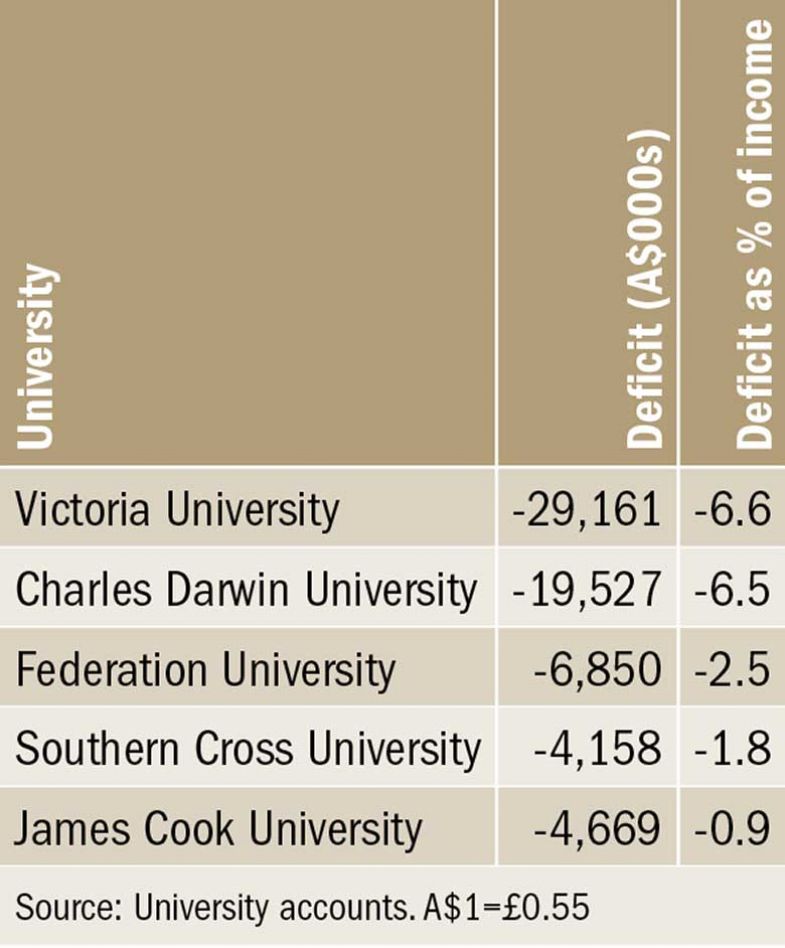The number of Australian universities in deficit doubled last year, as faltering demand pushed struggling institutions into more difficulty.
Annual reports show that expenses exceeded revenue at six universities in 2017, up from three the previous year. Five of the six were regionally based, with Melbourne’s Victoria University also recording a negative result.
Five of the six also experienced falling enrolments, suggesting that – as in the UK – the demand-driven system has exposed some universities to harmful competition for local students.
Australian universities are also locked in hot competition for foreign enrolments. The six loss-making institutions are well down the list of international student recruiters, collectively hosting just two-thirds as many as the University of Sydney which – along with other big Sydney and Melbourne institutions – has profited since 2014 by massively increasing its overseas student intake.
Three of the six loss-making institutions had declining international enrolments last year, according to education department data seen by Times Higher Education. Four also surrendered domestic enrolments.
Sector-wide admissions data released by the Australian government on 28 October showed that domestic applications fell this year for the first time this decade, by 3.3 per cent. Acceptances were down by the same rate.
Australia: largest deficits

Grattan Institute higher education programme director Andrew Norton said that the number of fee-paying postgraduate students at regional universities was “flat or declining”, and that their relatively few international students paid lower fees than those at large urban institutions.
He said that the government’s capping of teaching grants last December would inflict more damage, mainly because of the loss of indexation.
“On all fronts, the overall position is not terribly favourable to them. It definitely does not mean they’re about to go broke, but sustained deficits would be a problem,” Mr Norton said.
The largest deficit, of A$29.2 million (£16.1 million), was at Victoria University. Charles Darwin University recorded a A$19.5 million loss.
Mr Norton said that Australian universities had been in trouble before, but had never been allowed to go bust.
“Even if they can’t manage to get themselves back on track within their own resources, it’s hard to imagine that neither a state nor a federal government would intervene to stop them going under,” he said.
In 2017, the average surplus across the country’s 38 public universities declined to 4.7 per cent of revenue, down from 5.2 per cent in 2016. Sixteen universities recorded operating margins below 5 per cent, long considered a threshold buffer to finance the maintenance and improvement of university infrastructure – although some experts say that margins of 10 to 15 per cent are more appropriate.
The average operating margin at the 11 regionally based universities was just 2.4 per cent. The Regional Universities Network said that the overall funding settings, rather than competition among universities, were putting stress on institutional finances.
Executive director Caroline Perkins said that regional universities were anchor institutions that helped make their communities viable. “It comes down to the decision: do you want to encourage people to live in the regions? If so, it’s in the nation’s interests to keep regional universities going,” she said.
Charles Darwin University vice-chancellor Simon Maddocks said that governments should recognise the sector’s diversity “rather than expect us to operate under a one-size-fits-all policy”.
“Australia’s regional universities typically carry a higher load of low socioeconomic status students and operate over great distances, all of which place particular stresses on our institutions,” he said.
Victoria University blamed its deficit on “major restructure costs” associated with the transition to its block teaching model, and predicted a surplus this year.
后记
Print headline: University deficits increase as students flock to elites




